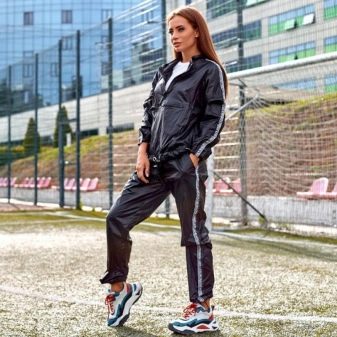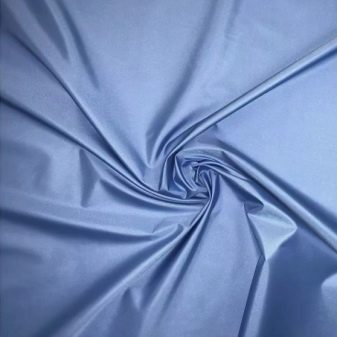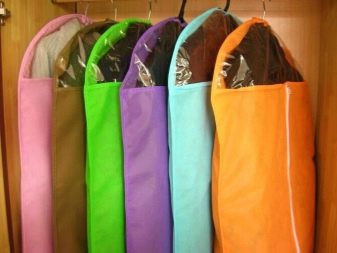All about raincoat fabric

Weather conditions are sometimes unpleasant and require special protection. For these purposes, fabrics were created with waterproof and windproof qualities. The unpretentious raincoat fabric does an excellent job with these tasks and has many varieties.
What it is?
The raincoat fabric differs from other types of materials in that it is impregnated with a special composition that provides water repellency. The composition of the raincoat fabric can include natural or synthetic fibers, but the main thing in it is waterproof impregnation. Cotton fiber is often used in the backing, but this material by itself is unable to withstand unpleasant weather conditions. To add fabrics of the desired characteristics, mixed materials are created, into which synthetic winterizer and synthetics are introduced. To increase comfort in wear, elasticity and elasticity, strength, polyester, nylon or nylon, viscose are introduced into the composition.


These manipulations made it possible to create a fabric with the following properties:
- the ability to repel moisture;
- ease of care;
- aeration;
- durability, practicality, reliability;
- crease resistance;
- preservation of the pigment in the sun.
There are a number of advantages of a raincoat material that make it so popular:
- relative budget, allowing you to use fabric for sewing various things;
- the possibility of supplementing with heaters, respectively, versatility in terms of the time of year;
- the fabric is always relevant;
- versatility allows you to use it when creating different things;
- variety of species.


History
The impermeability of coatings that protect against bad weather conditions was appreciated in ancient times by the first hunters.And if at that time in history clothes were sewn from skins, then in antiquity the universal chlamyds looked more noble. However, raincoat fabrics were invented almost by accident when Charles Mackintosh splashed rubber on clothes during his research in chemistry. When the scientist realized what his imprudence had led him to, he was indescribable delight. Such an experiment with cotton showed that clothes can be easily made waterproof.
The chemist received a patent and named the fabric by his last name, and in the middle of the 20th century another important event took place. In the city of Bologna, Italy, the production of nylon-type fabrics, which was impregnated with a propylene layer, began. The material became known rather quickly and gained worldwide recognition. From bologna, they began to sew outerwear for the off-season and winter. After that, cloak fabrics were constantly developing, looking for new forms, improving their properties. Today, this material is used to make clothes and other things.


Description of species
There are actually quite a few varieties of impregnated raincoat material. There is a thinner or denser fabric, it is almost always blended, but the composition varies.
Oxford
This fabric was created in order to sew blouses and shirts for Oxford students, hence the name. For manufacturing, the Panama-type matting technique is used. The result is an original material with a unique texture. Ornament - sharply outlined small squares, which are arranged like checkerboard cells. The fabric is waterproof, waterproof properties are very good: this is provided by polyurethane impregnation. Also in the composition there is lycra, which gives firmness and elasticity.
Visually, the fabric is very aesthetic, comfortable to use and very reliable. Oxford raincoat fabric repels not only water, but also dust, stains, it is very wear-resistant, while being quite budgetary.
But there are also disadvantages, for example, the material accumulates static electricity and can lose its shape from high temperatures.


Jordan
This material belongs to synthetic, based on polyester, which is also impregnated with polyurethane. The fabric has strength, elasticity, the fibers are intertwined so that a plain fabric is obtained, smooth and pleasant to the touch. Silky and shiny are the hallmarks of Jordan. It has a two-layer structure, it keeps and retains heat well, so you can use Jordan without lining. Among the best qualities of this variety are water repellency, resistance to ultraviolet light and other external influences.
Durability allows things made of this material to retain their original appearance for a very long time. Among the disadvantages, it is worth noting the ability to electrify, but when using special-purpose sprays, this disadvantage is leveled. This fabric is unpretentious in care, it can be machine washed. There is no need to iron things, as they do not wrinkle at all.


Taslan
This canvas is incredibly light, especially in comparison with other raincoat "brothers". The weight of one square meter of fabric fits into a small 200 grams. Taslan is created using a special weaving of rep-type threads. It is formed on the surface by scars located diagonally. Among the positive properties of taslan are practicality, strength and durability, low hygroscopicity. The material endures the effects of ultraviolet radiation and other external factors, does not deform and is easily cleaned of any dirt. In addition, it is comfortable to wear, aesthetically pleasing, and suitable for creating items of a children's category. But Taslan is whimsical in care: you need liquid type products and neat ironing.


Other
There are other types of raincoat fabric that are in demand and are in demand in various industries.
Membrane
The membrane itself is not an independent variety; it is an additional thin-type coating. It is applied to different types of fabrics. Raincoat fabric this layer is needed to enhance protection in rainy, windy, snowy weather. In terms of structure, the membrane is divided into two types.
- Two-layer. In this case, the membrane layer is located between the backing and the base. This is a pretty budget look.
- Three-layer. The base, membrane and lining seem to merge with each other and are a single whole. Such a canvas is much stronger, more elastic, but it also costs accordingly, since it is more difficult to produce.


Membrane raincoat fabric has the following classification:
- porous: permeable to steam, water-repellent;
- non-porous: accumulates steam on an internal surface.
Among the advantages of this type of raincoat fabric, we note the following: it is lightweight, comfortable, aerated and perfectly suited for bad weather.


Twill
The material perfectly repels moisture, which is facilitated by a special weaving of fibers - twill. In the process, diagonal lines are formed, which are located on the surface. The basis is wool, there are additions of cotton, polyester. This option is hypoallergenic, it keeps its shape excellent.


Duspo
This type of raincoat fabric is subdivided into several subspecies, but the basis of all is polyester. The fibers are woven in the same way, they are all impregnated additionally. But the impregnation is different:
- milki - light milky color;
- rey - mother-of-pearl cloth;
- sire - glossy coated fabric.



Finally, there is a special raincoat fabric - camouflage. It is used exclusively for sewing products for hunting, fishing, and military affairs.


Color solutions
Cloak-type fabrics differ not only in composition and properties, but also in design. First of all, the fabric dyes well, so the possibilities of use are quite wide. Let's consider the main types by color.
- Black. From such a raincoat fabric, upper men's and women's clothing is sewn. Classic trench coats are most often black.
- Printed material. Variants with a pattern are actively used by the creators of children's things. But striped or checkered raincoat fabric is also used for the manufacture of adult wardrobe items. Camouflage print stands out; a lot of special-purpose clothes are sewn from such a mother.
- White. It is most often found in women's clothing collections. She is very elegant, showy and stylish, but catchy and easily soiled.
- Silver and gray. These tones are very often used for dyeing raincoat fabrics. Metallic shades are suitable for trendy things, and gray ones are as versatile as possible, suitable for men and women.
- Bright. Modern trends do not limit designers in creating clothes from the brightest fabrics, including raincoats.
Orange stands out, it is often used for sewing work clothes.


Areas of use
A lot of different things can be sewn from fabrics that repel water. These are mainly outerwear. Already from the name it is clear that such materials are used in the first place for sewing a raincoat.
- Women's and men's clothing. Raincoats, trench coats, jackets for the off-season, down jackets for the winter, coats - this is not a complete list of clothes in which bolognese is used. Overalls, windbreakers, clothing for sports are sewn from Jordan. Ski suits and other similar clothing for adverse weather conditions are sewn from a membrane.
- Baby clothes. Winter and demi-season jackets, semi-overalls, vests, overalls, tracksuits and windbreakers are sewn from Jordan, taslan. Modern brands are increasingly turning to membrane materials when sewing children's clothing.
- Equipment. Awnings, tents, backpacks, bags, covers are usually made of oxford. It is also used for making baby strollers. Wallets, bags, backpacks are sewn from taslan.



For sewing winter and demi-season clothing, different types of insulation are used. When choosing, you need to focus on the amount of insulation: seasonality depends on it. At the same time, even the thinnest things made of raincoat fabric, for example, windbreakers, are not suitable for wearing in the summer. The problem is that these types of fabrics do not allow air to pass through, so it will be very hot in them, overheating is possible.
Care
It is a mistake to think that raincoat fabrics do not require special care. Yes, they do not wrinkle and repel water well, but some varieties require strict adherence to the instructions.
- Washing. The optimum water temperature is 30 degrees, but in no case more than 40. If washed in hot water, the shape of the product may be distorted. Use a non-aggressive detergent, preferably liquid. Bleach and everything containing chlorine must not be used. The type of washing is delicate, if possible, it is better to wash it by hand.
- Removing stains. Since bleaches cannot be used, it is advisable to start fighting the stain as early as possible. If it's fresh, you can use regular dishwashing liquid or even toothpaste. You do not need to wash the entire product.
- Ironing. Such things, as a rule, do not require ironing. But if necessary, set the softest mode and use a layer of gauze or other thin fabric. You can use a steam generator with a vertical steaming type.
- Drying. Immediately after spinning, the item is sent to the hanger, carefully straightened so that no creases are formed in the process.
Refrain from drying on heating devices, near them and in the open sun.


By the type of fabric, there are the following care features:
- it is recommended to wash things from Jordan and Duspo fabrics by hand;
- taslan is not taken to dry cleaning;
- nylon raincoat fabric does not tolerate aggressive agents, in polyester it is tolerant of them.
The membrane requires a very special attitude - the most capricious of all varieties:
- do not tumble dry, do not spin;
- can be dry-cleaned, but only if there is an authorizing symbol on the label, otherwise the fabric may lose its ability to keep warm;
- hand and machine wash is permissible, but on a delicate cycle and in cool water;
- free-flowing washing powders are strictly prohibited, they clog the cells of the fabric;
- spinning and twisting are prohibited, the water must drain;
- drying only horizontal;
- so that the fabric does not lose its properties, it is recommended to periodically process it with special agents with fluoride;
- clothing from the membrane is stored in covers, otherwise the dust will clog the cells.










